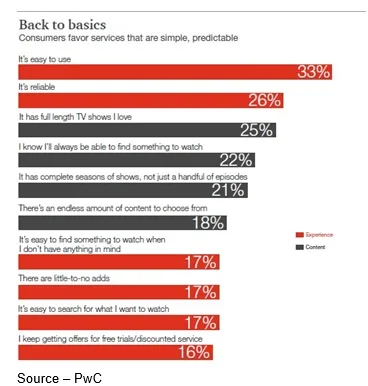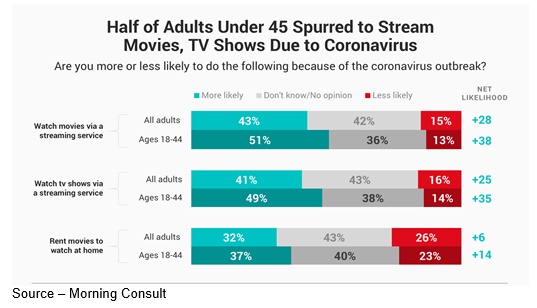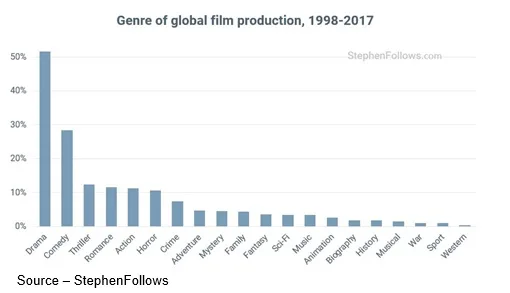It’s Time for the Next Generation of Streaming Service

While growing up in the midwest, a big deal every fall was going to the annual county fair, every day.
We became enthralled one year watching a barker hawking knives or pots/pans or something.
What intrigued us was that he would have this crowd gathered and then would switch to looking at/talking to three or four people in the crowd, almost ignoring everyone else.
And every time he went through his pitch, he’d do the same thing and the results were always the same … those individuals were the first in line to buy whatever it was he was pitching.
With their lead…others would follow.
We were amazed how quickly he could size up the crowd and identify who wanted what he was offering.
The idea is fundamentally the same for today’s D2C services.
But it’s different … way different.
We all know that Amazon has been looking over our shoulders for years, keeping track (to help us) of the stuff we look at and more importantly, what we buy.
Tracking what we buy also means they track that it arrives, that it wasn’t damaged in shipment and was what we expected.
If it doesn’t work out, Bezos will let us ship it back free.
… thanks Jeff.

So, they horde a lot of your personal data; and if they would only use it to help you, it would be good.
But honestly, if we received something like a chair mat, sending us a note two months later that says “they” found something we would be interested in and it was a chair mat, thanks but no thanks.
Then two months later, they come to us with another great idea. Yep … a chair mat.
Unlike our kids who get tired of asking and getting turned down, the Amazon data-scraping, recommendation machine doesn’t mind that we swore at it the last time we deleted its recommendations because … well, it has no feelings to be hurt.
Nope. It’s a non-empathic tool designed to do one thing–connect and sell!
Now the king of the SVOD hill, Netflix, has an arguably more comprehensive recommendation machine because it recommends shows/films “it” thinks we’ll like to watch based on stuff we’ve watched before.
There are times when we simply ask it for “something” it suggests stuff that makes us say “WTF?” or “Yeah…we liked that last week…remember.”

But we don’t really get mad because most of the information it receives is from us and the other 190M plus global subscribers is used to help Sandaros, Hastings and crew to create or buy new content that most of us will want to watch.
The project selection tools work because Hub Entertainment Research found that more than half (54 percent) signed up to watch a particular show.

In addition, most subscribers (17-74) regularly watch at least one hour of their content a week.
In fact, over 23 percent said Netflix had the best original shows.
That’s probably why Hub also found that 44+ percent of folks said Netflix was indispensable.
But we keep them on their toes because we also watch Disney+ (including their sibling Hulu), Amazon, Apple TV + and CBS All Access.
And these are just a few of the over 600 streaming services that are now in the US–all of which like to brag about their great libraries.
The truth is we really don’t care about your library. We want new, unique stuff.
If we want to check content out of the library, we also have free sources – Pluto, IMDb TV, Tubi.
It’s true, we have to watch a couple of minutes of improving ads preroll or midshow, but that’s okay having been raised on 15-20 minutes of ads with the pay TV we left.
But it’s not about ads vs. no ads, it’s about our content … the programming we want to watch!
That’s where all of our D2C services fall short.

All of our services deliver a decent UX.
You sign in and they look at viewing data to see what shows, movies you watched and say, “Okay, based on your favorites here is some stuff you’ll probably like.”
But if you’re like us, your tastes are pretty broad. Over the past month we’ve watched some very interesting documentaries, a number of dramas, some sci-fi flicks, a few action hero films, a few cop/crime series and even a few romcoms my wife was interested in.
So, picking a program that’s going to strike our fancy right then is more like a lucky guess. At least they know what won’t spark our interest.
Usually, they’ll end up showing some options on what’s trending now, what has been most popular or “hey here’s some new stuff we just put up you should consider.”

So yes, they do a decent job of sifting through their line-up, their library to try and be a little helpful.
Probably the worst recommendation is “people like you” have found these shows/films interesting.
In other words, they pooled the data from their 100+ million subscribers, divided it into segments (age, sex, marital status, race, other criteria) and determined where we’re like some of these viewers.
Sorry, but that isn’t a very personal recommendation.
Actually, it’s all about them and not really about you.
It’s true.
Four subscriptions, three free services and not one of them knew that when the kids missed going to the theater for shows we paid Universal $20 to watch Trolls World Tour online.

Then, when Disney decided to offer Mulan online rather than stuff it in the back of the closet until theaters finally open, they’d follow Universal’s lead but at a Disney price.
At first, we were a little irritated at the $30 tab but then realized that was less than taking the four of us to the movie house, pay for the tickets and drop another $50 plus for popcorn, sodas and junk food.
It turns out it was a bargain.
Can’t wait for Pixar’s Soul to drop into the Disney + schedule at Christmas so we can enjoy it and … Die Hard!
When we find the shows/movies we want to watch we’re happy, but D2C has a long way to go to become customer centric.
It’s a topic we have “discussed” with Allan McLennan, chief executive of PADEM Media Group, many times.
Streaming services do a decent job of getting, using, protecting our personal data but then they treat it like their data.
“Data capture and use are the bread and butter of every streaming service,” said McLennan. “It helps to intelligently recommend shows/films and it provides the guidance they need to greenlight future projects, so the personal data is an invaluable asset.
“Netflix rigorously protects/uses subscriber data,” he continued. “So does Disney, Amazon and Apple; and they are adamant about the fact that they will not share that information.”
While that sounds reassuring to the service subscribers, McLennan pointed out that it results in the subscriber’s data being in three to eight different service silos, presenting more opportunities for cyber criminals to steal and use an individual’s data.
“In today’s hack-happy world that is a concern,” he noted, “but it means these services can develop and recommend many new titles that potentially offer a myopic view rather than a better understanding of the customer’s total entertainment taste.”
Let’s state the obvious – everyone on the planet has a different set of viewing preferences.

For example, our son really enjoys Big Bang Theory. Daughter liked Glow. My wife was really into Great British Baking Show. We’re into documentaries and sci-fi.
According to the MPA (Motion Picture Association), the differences are what helped studios, content owners and indie filmmakers around the globe rack up more than $100B last year
When we cut our relationship with our pay TV provider and moved to our various streaming services, it was with the idea that we could watch what we want, when we want, where we want … and not have to wade through seven different services to find the right stuff!
“We have more than 2000 international, regional and local VOD services now post COVID, with all of them focusing on optimizing their customer base and content library,” said McLennan.
“It’s logical,” he noted, “but the single-minded approach doesn’t always focus on the viewer who simply wants an easy-to-use, satisfying content discovery and recommendation solution. We’ll get there … it will just take time.”
No, it’s not single-minded, it’s exacerbating!
There are third-party solutions like Apple TV, Amazon Fire TV and Roku that bring together the majority of streaming offerings so you can “click” through the options until you find a show/movie that interests you.
They’re good, not great.
An even better solution would be the complete overhaul/reinvention of yesteryear’s cable company that could offer pan-service selection for the customer.
The “new” bundle service would use a robust, AI-based content discovery engine that could quickly, effectively search across all of the available services to offer up a custom selection of viewing options to you.
And the service would undoubtedly become more precise in its recommendations as it “learned” more about your likes, dislikes, moods, viewing habits and more.
Doing that is as important as the value of the available content.
Cable companies like Comcast/Sky and others already have the infrastructure in place and the experience of how to efficiently, effectively deliver content to your screen. They could free up today’s streaming services to focus on extending the lifecycle of their IP, discover new audiences, develop even more interesting content and minimize/eliminate subscriber churn.
 We’ve reached a pivotal point in the industry where “best” content isn’t enough to attract – and keep – an audience.
We’ve reached a pivotal point in the industry where “best” content isn’t enough to attract – and keep – an audience.
It doesn’t take a rocket scientist to see what people want and need is a personal channel … a channel of one!
If a tuned-in, talented carnie can find his/her customers in a crowd, how hard can it be for dispassionate, people-developed AI recommendation tools to satisfy your entertainment wants/needs?
The tools are only as good as the developers.
As Stem so aptly noted in Upgrade, “It does not make sense that humans deliberately malfunction.”
# # #
Andy Marken – [email protected] – is an author of more than 700 articles on management, marketing, communications, industry trends in media & entertainment, consumer electronics, software and applications. Internationally recognized marketing/communications consultant with a broad range of technical and industry expertise especially in storage, storage management and film/video production fields. Extended range of relationships with business, industry trade press, online media and industry analysts/consultants.